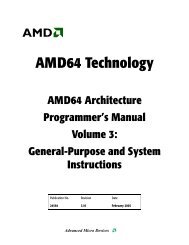Using TCP Through Sockets
Using TCP Through Sockets
Using TCP Through Sockets
You also want an ePaper? Increase the reach of your titles
YUMPU automatically turns print PDFs into web optimized ePapers that Google loves.
static void<br />
runfinger (int s)<br />
{<br />
char *user;<br />
}<br />
/* Read the username being fingered. */<br />
user = readline (s);<br />
/* Now connect standard output and standard error to the socket,<br />
* instead of the invoking user’s terminal. */<br />
if (dup2 (s, 1) < 0 || dup2 (s, 2) < 0) {<br />
perror ("dup2");<br />
exit (1);<br />
}<br />
close (s);<br />
/* Run the finger command. It will inherit our standard output and<br />
* error, and therefore send its results back over the network. */<br />
execl (FINGER_COMMAND, "finger", "--", *user user : NULL, NULL);<br />
/* We should never get here, unless we couldn’t run finger. */<br />
perror (FINGER_COMMAND);<br />
exit (1);<br />
int<br />
main (int argc, char **argv)<br />
{<br />
int ss, cs;<br />
struct sockaddr_in sin;<br />
int sinlen;<br />
int pid;<br />
/* This system call allows one to call fork without worrying about<br />
* calling wait. Don’t worry about what it means unless you start<br />
* caring about the exit status of forked processes, in which case<br />
* you should delete this line and read the manual pages for wait<br />
* and waitpid. For a description of what this signal call really<br />
* does, see the manual page for sigaction and look for<br />
* SA_NOCLDWAIT. Signal is an older signal interface which when<br />
* invoked this way is equivalent to setting SA_NOCLDWAIT. */<br />
signal (SIGCHLD, SIG_IGN);<br />
ss = tcpserv (FINGER_PORT);<br />
if (ss < 0)<br />
exit (1);<br />
for (;;) {<br />
sinlen = sizeof (sin);<br />
cs = accept (ss, (struct sockaddr *) &sin, &sinlen);<br />
14
















